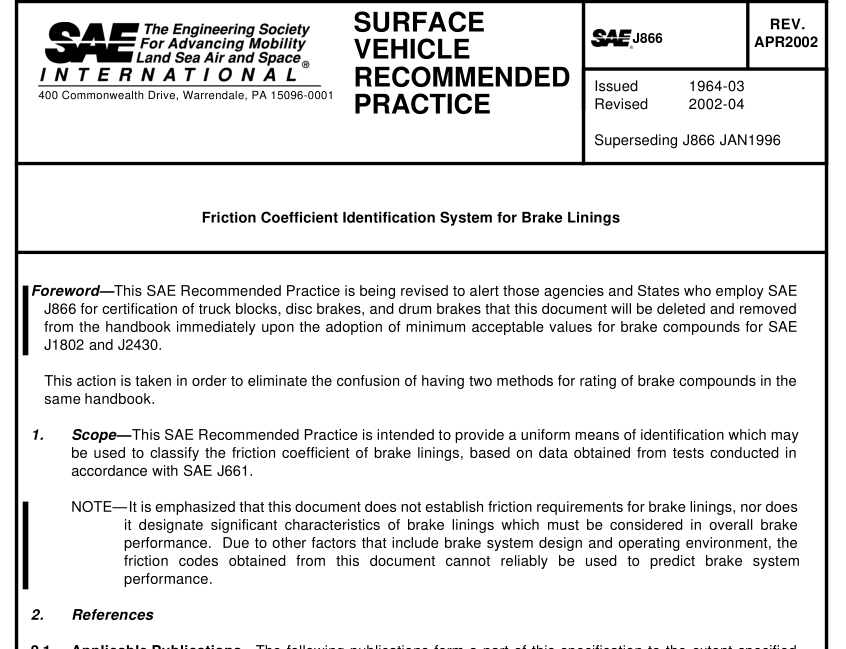SAE J866:2002 pdf download Friction Coefficient Identification System for Brake Linings
1. Scope—This SAE Recommended Practice is intended to provide a uniform means of identification which may be used to classify the friction coefficient of brake linings, based on data obtained from tests conducted in accordance with SAE J661 .
NOTE—It is emphasized that this document does not establish friction requirements for brake linings, nor does it designate significant characteristics of brake linings which must be considered in overall brake performance. Due to other factors that include brake system design and operating environment, the friction codes obtained from this document cannot reliably be used to predict brake system performance.
2. References
2.1 Applicable Publications—The following publications form a part of this specification to the extent specified herein. Unless otherwise specified, the latest issue of SAE publications shall apply.
2.1 .1 SAE P UBLICATIONS —Available from SAE, 400 Commonwealth Drive, Warrendale, PA 1 5096-0001 .
SAE J661 —Brake Lining Quality Control Test Procedure
SAE J2430—Dynamometer Effectiveness Characterization Test for Passenger Car and Light Truck Brake Friction Products
SAE J1 802—Brake Block Effectiveness Rating
3.1 The first letter will represent normal friction coefficient and the second will represent hot friction coefficient. 3.2 Normal Friction Coefficient—Normal friction coefficient is defined as the average of 4 points on the second fade curve, located at 93 °C (200 °F), 1 21 °C (250 °F), 1 49 °C (300 °F), and 204 °C (400 °F).
3.3 Hot Friction Coefficient—Hot friction coefficient is defined as the average of 1 0 points located at 204 °C (400 °F) and 1 49 °C (300 °F) on the first recovery; 232 °C (450 °F), 280 °C (500 °F), 288 °C (550 °F), 31 6 °C (600 °F), and 343 °C (630 °F) on the second fade; and 280 °C (500 °F), 204 °C (400 °F), and 1 49 °C (300 °F) on the second recovery. NOTE—If any temperature point or points required to calculate friction coefficients are not reached in the prescribed time limit, the coefficient of friction value at 1 0 min shall be used to give the full number of points required.
3.4 Example—A lining having a normal friction coefficient of 0.29 and a hot friction coefficient of 0.40 would be coded “EF”.
3.5 Location of Code—The appropriate code designation will be marked on an external noncontacting surface in letters not less than 2.8 mm in height where a brake lining is 3.2 mm or greater in thickness, or no more than 0.4 mm less than the thickness where the brake lining thickness is less than 3.2 mm.
4. Notes
4.1 Marginal Indicia—The change bar (l) located in the left margin is for the convenience of the user in locating areas where technical revisions have been made to the previous issue of the report. An (R) symbol to the left of the document title indicates a complete revision of the report.
SAE J866:2002 pdf download
